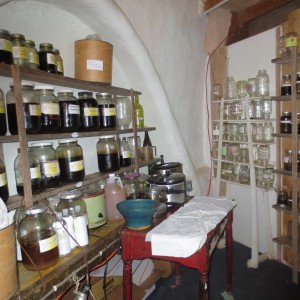
 Tinctures are concentrated herbal extracts that are made using alcohol, glycerin or vinegar with herbs that are fresh or dried. The tincture is especially effective in drawing out the essential compounds of plants, especially oils, and fibrous material from roots and resins. Since this method ensures that the herbs and their nutrients can be preserved for a long time, it is often mentioned in herbal books and remedies as a preferred way of using herbs.
Tinctures are concentrated herbal extracts that are made using alcohol, glycerin or vinegar with herbs that are fresh or dried. The tincture is especially effective in drawing out the essential compounds of plants, especially oils, and fibrous material from roots and resins. Since this method ensures that the herbs and their nutrients can be preserved for a long time, it is often mentioned in herbal books and remedies as a preferred way of using herbs.
In addition, many herbalists love tinctures for other beneficial reasons, such as their being easy to carry, their utility for long-term treatments, and their ability to be absorbed rapidly, as well as allowing for immediate dosage changes. As well, should the tincture prove bitter, it’s easily added to juice to disguise the flavor. Another benefit of tinctures is that they keep nutrients from the plants in a stable, soluble form and they retain the volatile and semi-volatile ingredients that are otherwise lost in heat-treatment and processing of dry herbal extracts.
Steps
1. Purchase quality alcohol. The preferred type of alcohol for producing a tincture is grain alcohol preferrably organic made from grapes. If you cannot obtain grain alcohol- vodka, brandy, or rum can be substituted. Whatever alcohol is chosen, it must be 80 proof (namely, 40% alcohol) to prevent mildewing of the plant material in the bottle.
It is also possible to make a tincture from quality apple cider vinegar or glycerin. The alternatives may work better where the patient refuses alcohol.
2.Use a suitable container. The container for the tincture should be glass or ceramic. Avoid using metallic or plastic containers because these can react with the tincture or leach dangerous chemicals over time. Items such as a Mason jar, a glass bottle with an attached stopper, etc., are ideal for steeping a tincture. In addition, you will need to get some small dark glass tincture bottles for storing the tincture in once it has been made; these bottles should have a screw on eye- dropper to prevent air intrusion during storage and to allow for ease of use.
3.Prepare the tincture. You can prepare a tincture by measurement or by sight; it really depends on your level of comfort with simply adding herbs and judging by eye, or whether you feel more comfortable adding them by measured weight. Also, you should know whether you want to add fresh, powdered, or dried herbs to the tincture. Some suggestions for adding the herbs in the order of fresh, powdered, or dried are as follows:
Add enough fresh chopped herbs to fill the glass container. Cover with alcohol.
Add 4 ounces (113g) of powdered herb with 1 pint (473ml) of alcohol (orvinegar/glycerin).
Add 7 ounces (198g) of dried herb material to 35 fluid ounces (1 liter) of alcohol (or vinegar/glycerin).
5.Shake up the jar and seal the container with plastic wrap under the lid. Place it into a cool, dark area; a cupboard shelf works best. The container should be stored there for 2 weeks to a month and its advisable to shake it occasional
Be sure to label the steeping tincture so that you know what it is and the date on which it was made.
6. Once the steeping time is finished strain the tincture as follows:
Place a muslin cloth across a sieve. Place a large bowl underneath to catch the strained liquid.
Gently pour the steeped liquid through the muslin-lined sieve. The muslin will capture the plant material and the liquid will pass through into the bowl underneath.
Press the herb material with a wooden or bamboo spoon to squeeze out some more liquid, and lastly, twist the muslin to extract any leftover liquid from the herbs.
7.Decant the liquid into a 1 oz. tincture bottle. Use a small funnel or measuring cup for this step if you don’t have a steady hand.
8. A tincture can have a shelf life of up to 5 years owing to the fact that alcohol is a preservative but I have found that they depreciated considerably. Once opened and used it is advisable to continue treatment until you have used up the 1 oz. bottle.
I am a synergist and believe that if you combine herbs you will counteract any possible side effects from one. It is good to monitor the effects of the herbal formula you are using. If you need more information please feel free the use the consultation page and get in touch with me.

